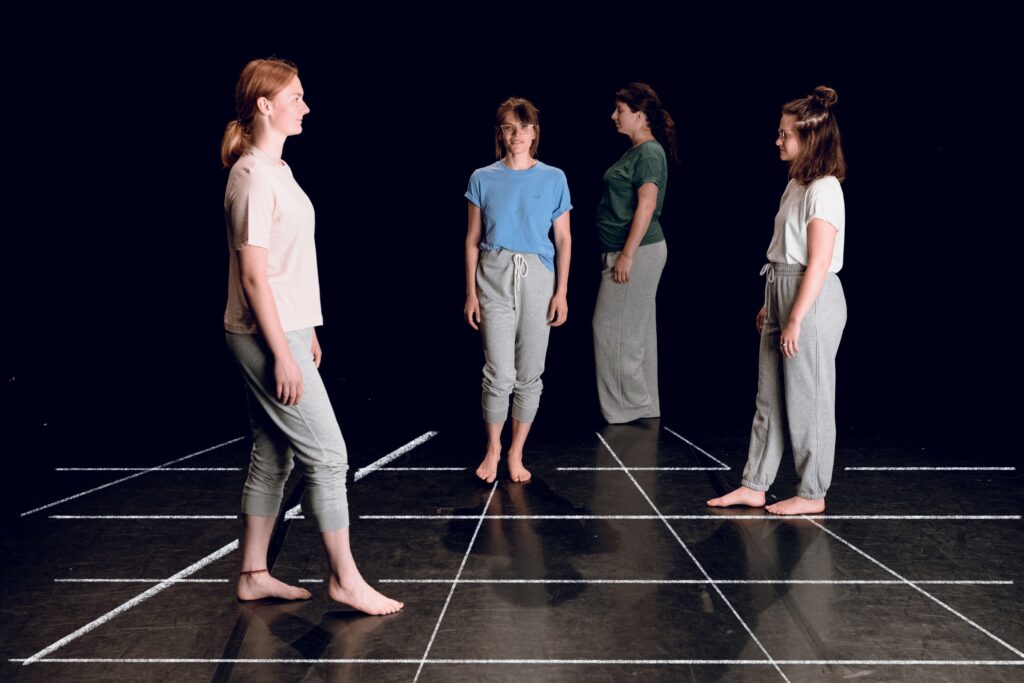(Based on the exercises described in Bogart & Landau’s (2005) The Viewpoints Book, Chapter 5: Introducing the Individual Viewpoints)
EXERCISE 1
I have borrowed this exercise from the Viewpoints training and transformed it for the groups of untrained performers. As a result of practicing the Grid exercise with many different groups and non-professionals, I realized that the strict rules of this game form the basis for understanding what “extreme listening” and “awareness of every single moment” mean.
Ask all the group members to create a line on the edge of the stage standing next to each other with about half a metre spacing. All facing towards the stage.

Say that each of them can move only following the structure of a grid. Each of them will imagine their own type of grid. It means that they can move only on lines intersecting each other at 90° angles. Let them try it first, so you can see if they all understand the assignment. Then ask them to go back to the starting position and stand in line next to each other. Tell them to remember the “neutral position” and to wait for an external impulse. This game is based on reacting to impulses coming from outside. Tell them to use their peripheral vision.
When the group starts moving, carefully watch the way they handle the individual assignments. Some of the Viewpoints such as repetition, tempo, kinaesthetic response, duration, spatial relationship and topography can be practised by anybody in any group and incorporated into the further creative process. As group members move on the grid, stop them anytime one of these Viewpoints appears by itself. Point at this moment and ask the group to keep this discovery while continuing the Grid game. When you guide the group through those Viewpoints, take a short break for feedback.
Then ask the group to do this exercise again considering all the elements you have worked with so far. Give them around 10 minutes. When it is finished, do a feedback session again.
Questions to ask: “What have you experienced? What challenged you the most? What did you enjoy the most?” and so on.
EXERCISE 2
In the second exercise you ask the participants to split into two small groups. These two groups will do the same exercise separately. When one group does it, the other observes and vice versa. At this phase of work, people are already confident with “being watched”. The presence of the audience raises their level of concentration and creates the possibility of giving more detailed feedback to each other. When the first group finishes the exercise, they take the In the second exercise you ask the participants to split into two small groups. These two groups will do the same exercise separately. When one group does it, the other observes and vice versa. At this phase of work, people are already confident with “being watched”. The presence of the audience raises their level of concentration and creates the possibility of giving more detailed feedback to each other. When the first group finishes the exercise, they take the position of the audience and the second group goes on the stage. When both rounds are completed, invite all participants into the circle and take more time for a good feedback session.
For most of the participants, the Grid game provides a new aspect of perceiving the world and the reality around them based on abilities to observe, to embrace the moment and to reflect on it.
What we are exploring:
- Extreme listening through the whole body and all the senses
- All the basic elements of stage work at the same time
- The ability to act without a previous concept or plan
- Moments of personal creativity
- Aspects of personal and common movements
- The joy of being part of a creative process
- Obstacle: Being allowed to move only in straight lines and right angles without speaking or making gestures
At the end of this session, emphasize that we should keep what we have experienced in this game in the upcoming steps of the creative work. The show Those Who Speak for Themselves is based on four 15-minute scenes taking place simultaneously in an open space. It was not a predetermined concept to construct the show in this way. We had tried it as a way of examining the concepts of “extreme listening” and “awareness”. Being aware of those principles led to a unique group discovery regarding the dramaturgy and the structure of the show.

